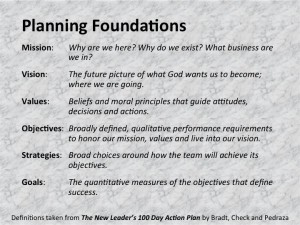
09.09.15 | Leader Development, Congregational Development | by Christie Latona
by Christie Latona
Strategic planning means different things for different people. When churches ask for strategic planning or visioning support, I have learned to ask the following:
- The mission of the United Methodist Church is "To make disciples of Jesus Christ for the transformation of the world." Do you have a clear definition and understanding of what exactly that means in your congregation?
- What is your current mission or purpose statement? How many people know it? How does it inform decision making, goal setting and the focus of the church?
- Looking at the definitions below, which planning foundations are strong and which are needed? What do you spend most of your time on in council meetings? Where do you tend to get stuck? Where is the most energy?

The way in which leaders answer those three sets of questions determines how planning time should be spent. And, yes, they are listed in this order for a reason: if the answer is no for #1, we start there. Often our congregations have goals that aren't related to a shared mission, vision or values. Too often the energy and time is going into things that are more about our preferences and programs than about world-transforming disciples working with the Holy Spirit to form other world-transforming disciples. In those cases it is important that we get the foundation strongly re-rooted in God's mission for us and the world. This is not be a marketing or wordsmithing exercise. This is not an exercise to satisfy charge conference forms. Prayerfully, this is a clarifying, focusing spiritual practice that transforms lives, congregations and communities.
